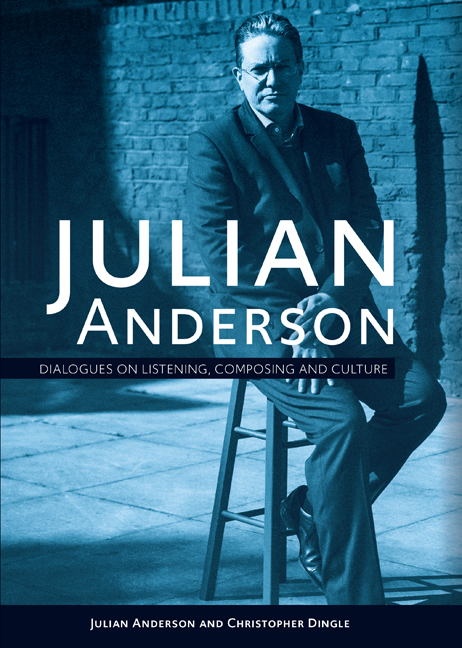Book contents
- Frontmatter
- Contents
- List of Illustrations
- Foreword
- Acknowledgements
- Introduction
- Prelude – Jeux: A Conversation Over Lunch
- Conversation One Origins
- Conversation Two Enthusiasms
- Conversation Three Training
- Conversation Four Dance
- Conversation Five Folk
- Conversation Six Composing (or Not)
- Conversation Seven Understandings
- Conversation Eight Beginnings (and Endings)
- Conversation Nine Puzzles
- Conversation Ten Singing
- Conversation Eleven Olly
- Conversation Twelve Memory
- Conversation Thirteen Opera
- Conversation Fourteen Practices
- Conversation Fifteen Outsiders?
- Conversation Sixteen Quartets
- Conversation Seventeen Advocacy
- Conversation Eighteen Partnerships
- Coda: Multiple Choices
- Chronology
- List of Personae
- Glossary of Musical Terms
- Macrotonality
- Catalogue of Published Works by Julian Anderson
- List of Recordings of Julian Anderson’s Music
- Bibliography
- Discography
- Index
Prelude – Jeux: A Conversation Over Lunch
Published online by Cambridge University Press: 16 September 2020
- Frontmatter
- Contents
- List of Illustrations
- Foreword
- Acknowledgements
- Introduction
- Prelude – Jeux: A Conversation Over Lunch
- Conversation One Origins
- Conversation Two Enthusiasms
- Conversation Three Training
- Conversation Four Dance
- Conversation Five Folk
- Conversation Six Composing (or Not)
- Conversation Seven Understandings
- Conversation Eight Beginnings (and Endings)
- Conversation Nine Puzzles
- Conversation Ten Singing
- Conversation Eleven Olly
- Conversation Twelve Memory
- Conversation Thirteen Opera
- Conversation Fourteen Practices
- Conversation Fifteen Outsiders?
- Conversation Sixteen Quartets
- Conversation Seventeen Advocacy
- Conversation Eighteen Partnerships
- Coda: Multiple Choices
- Chronology
- List of Personae
- Glossary of Musical Terms
- Macrotonality
- Catalogue of Published Works by Julian Anderson
- List of Recordings of Julian Anderson’s Music
- Bibliography
- Discography
- Index
Summary
JA: The thing about Jeux I don't understand is why, every time I listen to it, it almost sounds like a different piece of music, one I hadn't heard before. I can recall sounds from it, gestures, melodies, harmonies and so on, but each time I hear the whole piece from beginning to end, I remember something different, sometimes very different.
CD: I looked at Jeux with the students the other week. Before playing the first page or two at the piano, I told those with absolute pitch to shut up. I then pointed out that Debussy introduces this little meandering, chromatic theme, has a little bit of a flourish, and then he sticks it up the octave, a classic compo-sitional gesture. Everyone said, ‘Fine.’ I then got them to look at the score and, even with that, it took a while before they realised he puts it up a major seventh, not an octave.
JA: That's the xylophone entry, yes.
CD: Yes, xylophone and strings. I find it remarkable the way Debussy can do something gracefully that would be so askew and distorting in pieces by other composers. The way he moves the harmony around is so fluid and plastic. I was flabbergasted when I first looked closely at the score to see just how saturated the chromatic space is. It is just as chromatic as Schoenberg, yet it sounds so full of light.
JA: It doesn't sound clogged, does it?
CD: No, and while it's not traditional diatonic harmony in the Mozartian sense, it doesn't sound atonal at all, even though it is just as chromatic as some atonal works. Nor does it sound like Tristan or that late-Romantic kind of chromatic saturation. It's astonishing to be able to do that and for it not to have the expressionist feel that you get from Schoenberg at the same time.
JA: Yes, it's mobile and free-floating, but it's not connected with that kind of strenuous chromaticism at all. As you say, it's not clear how that's been done. Even Debussy, one suspects, may not fully have understood what he’d done. There is another factor in Jeux that people occasionally neglect – they did in the ‘50s anyway – which is that he was following the plot.
- Type
- Chapter
- Information
- Julian AndersonDialogues on Listening, Composing and Culture, pp. 4 - 6Publisher: Boydell & BrewerPrint publication year: 2020



